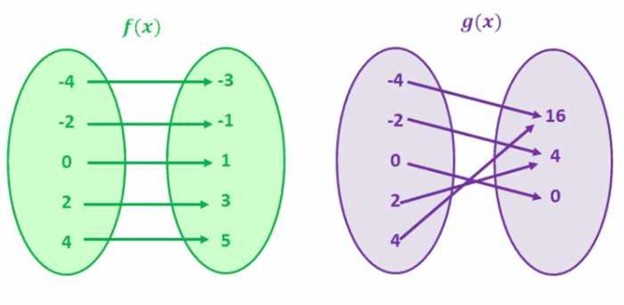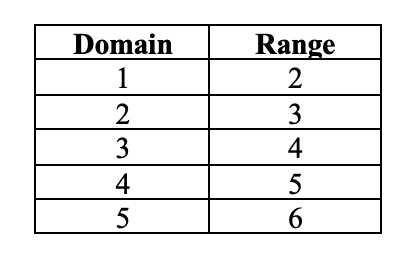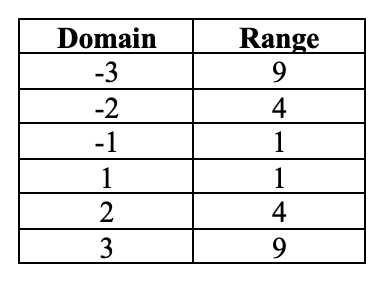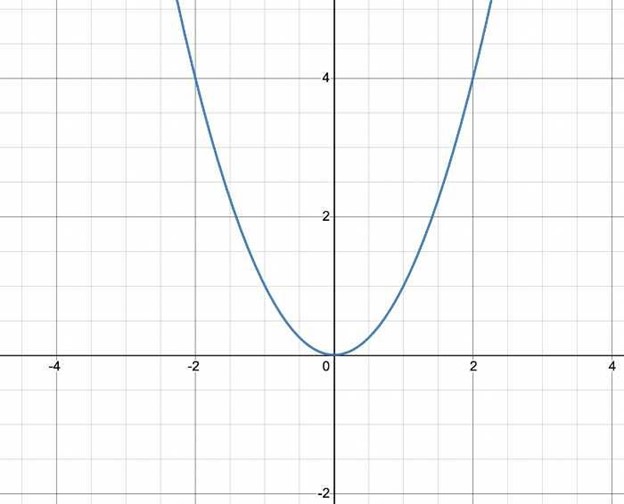One to One Functions - Graph, Examples | Horizontal Line Test
What is a One to One Function?
A one-to-one function is a mathematical function where each input corresponds to a single output. So, for every x, there is only one y and vice versa. This implies that the graph of a one-to-one function will never intersect.
The input value in a one-to-one function is the domain of the function, and the output value is the range of the function.
Let's study the pictures below:

For f(x), each value in the left circle correlates to a unique value in the right circle. Similarly, every value in the right circle corresponds to a unique value on the left side. In mathematical jargon, this signifies every domain has a unique range, and every range holds a unique domain. Therefore, this is a representation of a one-to-one function.
Here are some more representations of one-to-one functions:
-
f(x) = x + 1
-
f(x) = 2x
Now let's study the second example, which displays the values for g(x).
Be aware of the fact that the inputs in the left circle (domain) do not own unique outputs in the right circle (range). For instance, the inputs -2 and 2 have identical output, that is, 4. In the same manner, the inputs -4 and 4 have equal output, i.e., 16. We can see that there are identical Y values for many X values. Hence, this is not a one-to-one function.
Here are different representations of non one-to-one functions:
-
f(x) = x^2
-
f(x)=(x+2)^2
What are the characteristics of One to One Functions?
One-to-one functions have the following characteristics:
-
The function has an inverse.
-
The graph of the function is a line that does not intersect itself.
-
They pass the horizontal line test.
-
The graph of a function and its inverse are identical concerning the line y = x.
How to Graph a One to One Function
When trying to graph a one-to-one function, you will need to determine the domain and range for the function. Let's study a simple representation of a function f(x) = x + 1.

As soon as you possess the domain and the range for the function, you ought to graph the domain values on the X-axis and range values on the Y-axis.
How can you tell whether or not a Function is One to One?
To prove whether or not a function is one-to-one, we can leverage the horizontal line test. Immediately after you chart the graph of a function, draw horizontal lines over the graph. In the event that a horizontal line passes through the graph of the function at more than one spot, then the function is not one-to-one.
Because the graph of every linear function is a straight line, and a horizontal line doesn’t intersect the graph at more than one spot, we can also reason that all linear functions are one-to-one functions. Don’t forget that we do not leverage the vertical line test for one-to-one functions.
Let's look at the graph for f(x) = x + 1. Once you graph the values for the x-coordinates and y-coordinates, you ought to examine if a horizontal line intersects the graph at more than one spot. In this example, the graph does not intersect any horizontal line more than once. This means that the function is a one-to-one function.

On the contrary, if the function is not a one-to-one function, it will intersect the same horizontal line more than one time. Let's study the figure for the f(y) = y^2. Here are the domain and the range values for the function:

Here is the graph for the function:

In this example, the graph meets multiple horizontal lines. Case in point, for either domains -1 and 1, the range is 1. In the same manner, for either -2 and 2, the range is 4. This means that f(x) = x^2 is not a one-to-one function.
What is the opposite of a One-to-One Function?
As a one-to-one function has only one input value for each output value, the inverse of a one-to-one function also happens to be a one-to-one function. The inverse of the function essentially undoes the function.
Case in point, in the example of f(x) = x + 1, we add 1 to each value of x in order to get the output, i.e., y. The inverse of this function will remove 1 from each value of y.
The inverse of the function is known as f−1.
What are the properties of the inverse of a One to One Function?
The qualities of an inverse one-to-one function are the same as any other one-to-one functions. This signifies that the opposite of a one-to-one function will possess one domain for every range and pass the horizontal line test.
How do you figure out the inverse of a One-to-One Function?
Determining the inverse of a function is not difficult. You just need to swap the x and y values. For instance, the inverse of the function f(x) = x + 5 is f-1(x) = x - 5.

As we learned previously, the inverse of a one-to-one function reverses the function. Since the original output value required adding 5 to each input value, the new output value will require us to delete 5 from each input value.
One to One Function Practice Questions
Contemplate these functions:
-
f(x) = x + 1
-
f(x) = 2x
-
f(x) = x2
-
f(x) = 3x - 2
-
f(x) = |x|
-
g(x) = 2x + 1
-
h(x) = x/2 - 1
-
j(x) = √x
-
k(x) = (x + 2)/(x - 2)
-
l(x) = 3√x
-
m(x) = 5 - x
For any of these functions:
1. Figure out whether or not the function is one-to-one.
2. Draw the function and its inverse.
3. Find the inverse of the function numerically.
4. Indicate the domain and range of every function and its inverse.
5. Use the inverse to solve for x in each equation.
Grade Potential Can Help You Learn You Functions
If you find yourself facing difficulties trying to understand one-to-one functions or similar functions, Grade Potential can connect you with a 1:1 teacher who can help. Our Indianapolis math tutors are experienced educators who assist students just like you improve their understanding of these types of functions.
With Grade Potential, you can study at your own pace from the comfort of your own home. Plan a meeting with Grade Potential today by calling (463) 223-4385 to get informed about our tutoring services. One of our consultants will contact you to better ask about your needs to provide you with the best instructor for you!




